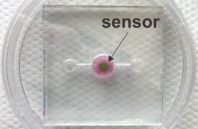A new photonic biosensor can track oxygen levels in real time in organs-on-a-chip to ensure that these systems are mimicking the function of physical organs.
Developed at North Carolina State University and the University of North Carolina, Chapel Hill, the biosensor employs a phosphorescent gel that emits IR light after being exposed to IR light, similar to an echo. The lag time between when the gel is exposed to light and when it emits the echoing flash varies, depending on the amount of oxygen in the system’s environment. The more oxygen, the shorter the lag time. By monitoring lag times, the researchers can measure the oxygen concentration in an organ-on-a-chip system down to tenths of a percent.
The biosensor is integrated into a 3D tissue scaffold during fabrication of the organ-on-a-chip, and oxygen concentration is regulated via the control of purging gas flow. The biosensor uses the quenching of palladium-benzoporphyrin by molecular oxygen to transduce the local oxygen concentration in the 3D tissue scaffold. Because IR light can pass through tissue, the researchers can use a reader, which emits IR light and measures the echoing flash from the phosphorescent gel, to monitor oxygen levels in the tissue repeatedly, with lag times measured in the microseconds.

 (585) 768-2513
(585) 768-2513

